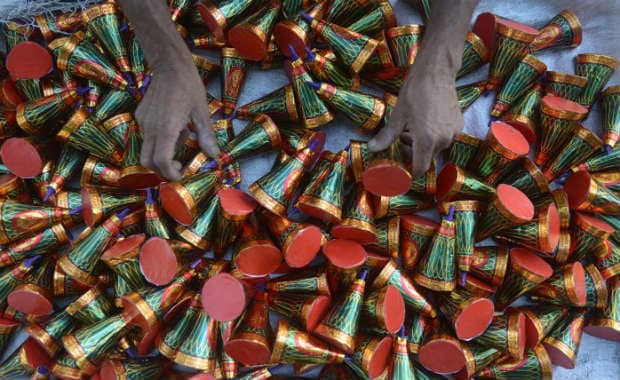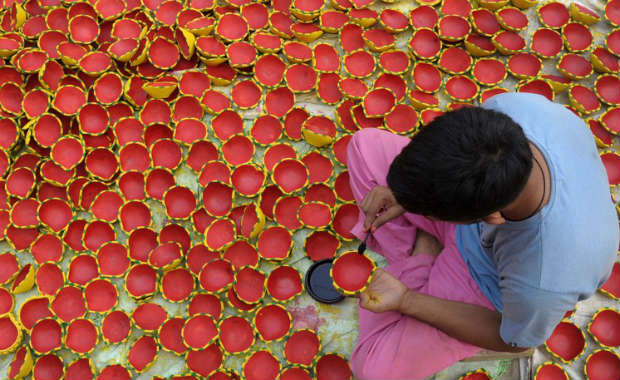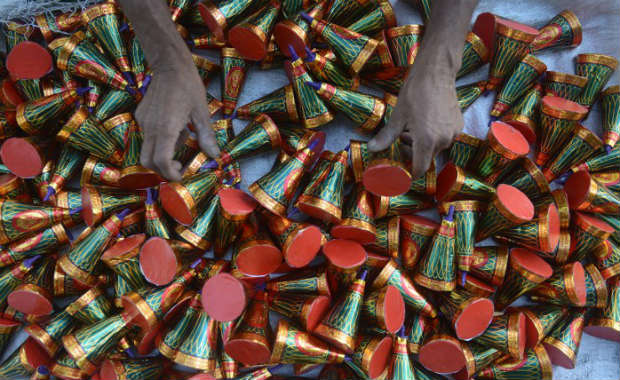Diwali season is around the corner and for most people in India this is the time to shop, and celebrate with family but the joyous occasion can often leave you with pangs of guilt. If you’re worried about the noise and sound pollution, or end up groaning about your electricity bill, or even the extra-kilos you gain post-Diwali, perhaps it’s time to do things differently. Here are three ways to ensure that this year’s Diwali is a guilt-free experience. Crackers: The first step to a guilt-free Diwali is getting rid of the fire-crackers. Sure for many of us Diwali is synonymous with bursting crackers and it’s kind of hard to give up on the fun, but there are enough reasons why this isn’t the best way to celebrate Diwali. For starters, the environmental hazard of fire-crackers should be enough to scare anyone off.
As an example, Delhi saw
the PM10 particle levels shoot up by five times after last year’s Diwali celebrations. In fact even SO2 levels were much higher, while in some areas the level of sound pollution also went up despite the 10 pm deadline. The pollutants associated with firecrackers make it difficult to breathe and are linked to other respiratory problems as well. And no, they’re not good for your pets either. [caption id=“attachment_1762583” align=“alignnone” width=“620”] There’s no food reason to be hanging on to fire-crackers. The noise and sound pollution alone should make these a no-no. AFP[/caption] The second reason to avoid firecrackers is due to the fact that many companies are still employing child labour in their factories. Reports from 2013 show that child labour is still rampant in these factories especially in Sivakasi in Tamil Nadu where a lot of these units are based. This
TOI report
for instance points out that despite a 1996 Supreme Court order which had led to the rescue of children in the late 1990’s, the ugly truth is that most factories are still employing child labour. If you must insist on buying firecrackers, go for those which have the branding that no child labour was involved. Also stick to things that light up the sky rather than bombs, which are just a sound nuisance. Go for anars, sparklers, and chakarginis instead of the 5000 ka ladi. A lot more people can enjoy these. Food: With Indian festivals, food is pretty much the most important thing you can count on. Plus Diwali is a good reason to chow down on everything that might not always be so good for your health. From laddoos to pedhas, to chole bhature to deep-fried homemade snacks like sev, it’s a culinary heaven for your taste buds, but not so good if you’re trying to manage your weight. For starters, where sweets are concerned go easy on the laddoos and instead replace them with some lighter desserts. A kheer made of just milk, rice, and a bit of sugar is a delicious offering and while it doesn’t pack the punch of the laddoos or rasamalais, it will be easier on your tummy. You can also try out sugar-free desserts, and if you’re diabetic like many Indians, you’ll probably have no choice. Check out some recipes by Tarla Dalal
here
. For instance this one
kheer and apple recipe
requires only a tablespoon full of sugar and has apples, dates, walnuts which are all good for you. [caption id=“attachment_1762591” align=“alignnone” width=“620”]
There’s no food reason to be hanging on to fire-crackers. The noise and sound pollution alone should make these a no-no. AFP[/caption] The second reason to avoid firecrackers is due to the fact that many companies are still employing child labour in their factories. Reports from 2013 show that child labour is still rampant in these factories especially in Sivakasi in Tamil Nadu where a lot of these units are based. This
TOI report
for instance points out that despite a 1996 Supreme Court order which had led to the rescue of children in the late 1990’s, the ugly truth is that most factories are still employing child labour. If you must insist on buying firecrackers, go for those which have the branding that no child labour was involved. Also stick to things that light up the sky rather than bombs, which are just a sound nuisance. Go for anars, sparklers, and chakarginis instead of the 5000 ka ladi. A lot more people can enjoy these. Food: With Indian festivals, food is pretty much the most important thing you can count on. Plus Diwali is a good reason to chow down on everything that might not always be so good for your health. From laddoos to pedhas, to chole bhature to deep-fried homemade snacks like sev, it’s a culinary heaven for your taste buds, but not so good if you’re trying to manage your weight. For starters, where sweets are concerned go easy on the laddoos and instead replace them with some lighter desserts. A kheer made of just milk, rice, and a bit of sugar is a delicious offering and while it doesn’t pack the punch of the laddoos or rasamalais, it will be easier on your tummy. You can also try out sugar-free desserts, and if you’re diabetic like many Indians, you’ll probably have no choice. Check out some recipes by Tarla Dalal
here
. For instance this one
kheer and apple recipe
requires only a tablespoon full of sugar and has apples, dates, walnuts which are all good for you. [caption id=“attachment_1762591” align=“alignnone” width=“620”] If you’re watching your weight, we suggest your forget about ladus and stick to kheer. Reuters[/caption] Where heavy foods go, if you can’t let go of chhole or the shahi paneer or even dal with butter floating on the top, go with atta ka puris, instead of deep-fried maida based bhature and skip the rice. Also for quick bites, go for those countless dry fruits that someone no doubt left at your home. Don’t hoard them for later. If you like your spicy snacks, go for things you can bake or roast, like Paneer Tikkas or even roasted small potatoes. But if you love fried snacks, we suggest you invest in an Air Fryer. It’s a good Diwali present for your waist-line. It will deliver the snacks, but without the food being covered in oil. Decorations: Diwali is the festival of lights, but that doesn’t mean you should end up with an electricity bill that hurts. As far as possible stick to lighting the house with diyas, since that is where the true essence of Diwali lies. If you don’t want to waste oil on each diya, candles are a solution and nowadays diyas with candles inside them are also easily available in the markets. When buying diyas and candles, try and get these from an NGO that is helping a community, since that would help those who are making them. To get a list of some of NGOs that are working in Mumbai, click
here.
[caption id=“attachment_1762585” align=“alignnone” width=“620”]
If you’re watching your weight, we suggest your forget about ladus and stick to kheer. Reuters[/caption] Where heavy foods go, if you can’t let go of chhole or the shahi paneer or even dal with butter floating on the top, go with atta ka puris, instead of deep-fried maida based bhature and skip the rice. Also for quick bites, go for those countless dry fruits that someone no doubt left at your home. Don’t hoard them for later. If you like your spicy snacks, go for things you can bake or roast, like Paneer Tikkas or even roasted small potatoes. But if you love fried snacks, we suggest you invest in an Air Fryer. It’s a good Diwali present for your waist-line. It will deliver the snacks, but without the food being covered in oil. Decorations: Diwali is the festival of lights, but that doesn’t mean you should end up with an electricity bill that hurts. As far as possible stick to lighting the house with diyas, since that is where the true essence of Diwali lies. If you don’t want to waste oil on each diya, candles are a solution and nowadays diyas with candles inside them are also easily available in the markets. When buying diyas and candles, try and get these from an NGO that is helping a community, since that would help those who are making them. To get a list of some of NGOs that are working in Mumbai, click
here.
[caption id=“attachment_1762585” align=“alignnone” width=“620”] Go for decorations that are environmentally friendly and also help out the community. AFP[/caption] In Delhi,
Muskaan is one such NGO
that is working with differently-abled people and you can buy diyas, small gift-backs from them. Or
check out Sparsh
which sells a range of Diwali-related products to help underprivileged kids, or TJs which are products made by Tihar Jail inmates (you’ll spot them at Select City in Saket) to name a few. Remember you can even give these away as gifts instead of going with the usual almond and kaju boxes. For decorations, the number of options are much more than just going for Chinese lights strewn all over the house, blinking constantly. Rangolis can be made of flower petals, or even natural colours, which are much more environmentally friendly. Hangings like Bandhanwars for homes are easily available everywhere and you can save these for later and reuse them for next Diwali as well. When choosing decorations, simply don’t just go for bling, make sure your choices are environmentally friendly. You can check out some eco-friendly diya holders at EcoTokri
here.
In conclusion, we know that Diwali is a time to relax and have fun and hopefully with these steps, your Diwali experience will be guilt-free as well this year..
Go for decorations that are environmentally friendly and also help out the community. AFP[/caption] In Delhi,
Muskaan is one such NGO
that is working with differently-abled people and you can buy diyas, small gift-backs from them. Or
check out Sparsh
which sells a range of Diwali-related products to help underprivileged kids, or TJs which are products made by Tihar Jail inmates (you’ll spot them at Select City in Saket) to name a few. Remember you can even give these away as gifts instead of going with the usual almond and kaju boxes. For decorations, the number of options are much more than just going for Chinese lights strewn all over the house, blinking constantly. Rangolis can be made of flower petals, or even natural colours, which are much more environmentally friendly. Hangings like Bandhanwars for homes are easily available everywhere and you can save these for later and reuse them for next Diwali as well. When choosing decorations, simply don’t just go for bling, make sure your choices are environmentally friendly. You can check out some eco-friendly diya holders at EcoTokri
here.
In conclusion, we know that Diwali is a time to relax and have fun and hopefully with these steps, your Diwali experience will be guilt-free as well this year..
No crackers to eco-friendly decorations: Three easy steps to a guilt-free Diwali
FP Staff
• October 21, 2014, 12:40:33 IST
Diwali season is around the corner and for most people in India this is the time to shop, to celebrate with family but there’s no reason why your celebrations can’t be guilt-free.
Advertisement
)
End of Article